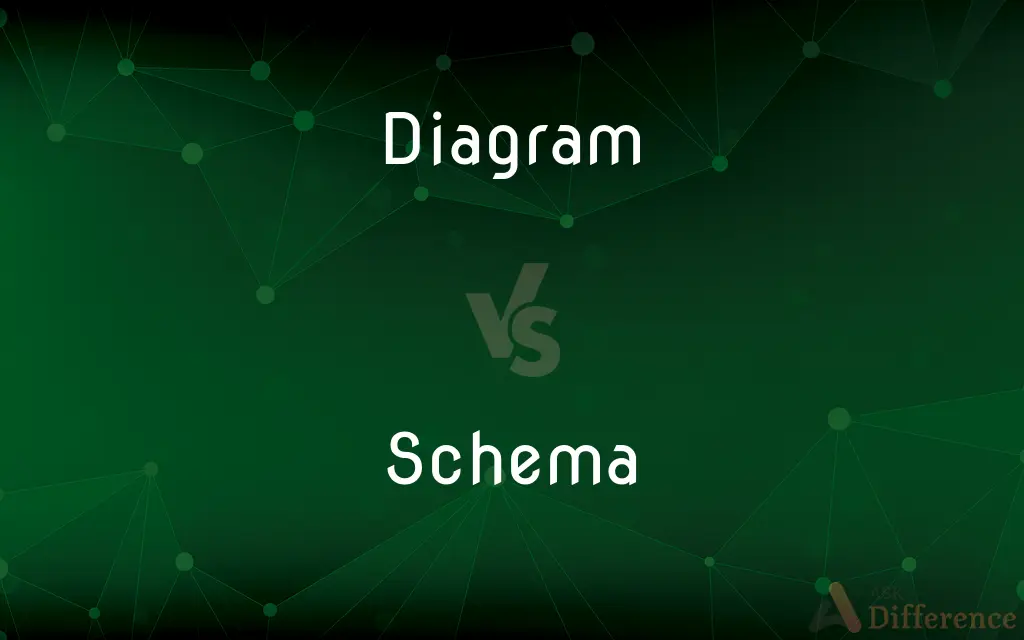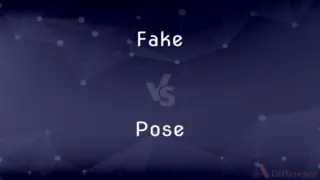Diagram vs. Schema — What's the Difference?
Edited by Tayyaba Rehman — By Maham Liaqat — Updated on April 26, 2024
Diagrams visually represent data or systems with shapes and lines to show relationships, while schemas are structured frameworks or blueprints that outline the organization of data and systems.

Difference Between Diagram and Schema
Table of Contents
ADVERTISEMENT
Key Differences
Diagrams are graphical representations used to illustrate the relationships and processes within a system, employing various symbols and lines to depict different components. On the other hand, schemas provide a conceptual framework that organizes and defines the structure of information or data systems, often used in databases and programming.
In educational and professional settings, diagrams are utilized to simplify complex information, making it easier to understand and communicate ideas visually. Whereas schemas are crucial in technical fields like computing, where they define how data is stored, processed, and related.
Diagrams vary widely in types, such as flowcharts, circuit diagrams, and network diagrams, each serving specific purposes depending on the field and subject matter. Schemas, however, primarily appear in structured forms like database schemas or XML schemas, focusing on the format and relationships within data.
The creation of a diagram is often more flexible, allowing for artistic freedom and adaptation based on the presenter’s needs. Conversely, schemas require strict adherence to predefined rules and standards to ensure they function correctly within their respective systems.
Diagrams are typically easier for the general public to interpret and use as they visually communicate information without needing specialized knowledge. In contrast, understanding and creating schemas often require technical expertise, particularly in areas like software development and database management.
ADVERTISEMENT
Comparison Chart
Definition
A visual representation of systems or data.
A structured framework outlining data or system organization.
Usage
To simplify and illustrate complex relationships.
To define and organize structures within technical systems.
Types
Flowcharts, network diagrams, circuit diagrams.
Database schemas, XML schemas.
Flexibility
High, with variations based on needs and creativity.
Low, must adhere to specific standards and rules.
Required Expertise
General knowledge suffices for basic diagrams.
Technical expertise in fields like computing or database management.
Compare with Definitions
Diagram
A tool used for problem-solving or to explain complex systems.
Engineers use network diagrams to plan and troubleshoot networks.
Schema
Often used in programming and web development.
Developers refer to the schema while integrating new features.
Diagram
Can be hand-drawn or computer-generated.
She sketched a simple diagram of the building's layout.
Schema
Integral to system architecture.
He updated the schema to accommodate new types of data.
Diagram
Often created using symbols and lines.
Circuit diagrams use symbols to represent electrical components.
Schema
A blueprint or framework for database design.
The database schema outlines the relationships between tables.
Diagram
Used in teaching to visualize concepts.
Diagrams of the human body are common in biology textbooks.
Schema
Used to define XML structures in software.
The XML schema specifies the elements and attributes used in the document.
Diagram
A graphic designed to represent information or data.
A flowchart is a type of diagram used to show steps in a process.
Schema
Requires specific syntax and structure.
Errors in the schema can lead to data inconsistencies.
Diagram
A diagram is a symbolic representation of information using visualization techniques. Diagrams have been used since ancient times on walls of caves, but became more prevalent during the Enlightenment.
Schema
A plan, outline, or model
A schema for prioritizing vaccinations.
A writer's schema for a novel.
Diagram
A simplified drawing showing the appearance, structure, or workings of something; a schematic representation
A diagram of the living room
Schema
(Psychology) A pattern imposed on complex reality or experience to assist in explaining it, mediate perception, or guide response.
Diagram
Represent (something) in graphic form
The experiment is diagrammed on page fourteen
Schema
An outline or image universally applicable to a general conception, under which it is likely to be presented to the mind (for example, a body schema).
Diagram
A plan, sketch, drawing, or outline designed to demonstrate or explain how something works or to clarify the relationship between the parts of a whole.
Schema
(databases) A formal description of the structure of a database: the names of the tables, the names of the columns of each table, and the data type and other attributes of each column.
Diagram
(Mathematics) A graphic representation of an algebraic or geometric relationship.
Schema
(markup languages) A formal description of data, data types, and data file structures, such as XML schemas for XML files.
Diagram
A chart or graph.
Schema
(logic) A formula in the metalanguage of an axiomatic system, in which one or more schematic variables appear, which stand for any term or subformula of the system, which may or may not be required to satisfy certain conditions.
Diagram
To indicate or represent by or as if by a diagram.
Schema
(Christianity) A monastic habit in the Greek Orthodox Church.
Diagram
A plan, drawing, sketch or outline to show how something works, or show the relationships between the parts of a whole.
Electrical diagrams show device interconnections.
Schema
An outline or image universally applicable to a general conception, under which it is likely to be presented to the mind; as, five dots in a line are a schema of the number five; a preceding and succeeding event are a schema of cause and effect.
Diagram
A graph or chart.
Schema
An internal representation of the world; an organization of concepts and actions that can be revised by new information about the world
Diagram
(category theory) A functor from an index category to another category. The objects and morphisms of the index category need not have any internal substance, but rather merely outline the connective structure of at least some part of the diagram's codomain. If the index category is J and the codomain is C, then the diagram is said to be "of type J in C".
Schema
A schematic or preliminary plan
Diagram
(transitive) To represent or indicate something using a diagram.
Diagram
(UK) To schedule the operations of a locomotive or train according to a diagram.
Diagram
A figure or drawing made to illustrate a statement, or facilitate a demonstration; a plan.
Diagram
Any simple drawing made for mathematical or scientific purposes, or to assist a verbal explanation which refers to it; a mechanical drawing, as distinguished from an artistical one.
Diagram
To put into the form of a diagram.
Diagram
A drawing intended to explain how something works; a drawing showing the relation between the parts
Diagram
Make a schematic or technical drawing of that shows how things work or how they are constructed
Common Curiosities
In what ways are schemas critical to software development?
Schemas are essential for defining data structures, ensuring consistency, and facilitating data manipulation in software applications.
What are the benefits of using a schema in database design?
Schemas help organize database elements, ensure data integrity, and optimize queries by clearly defining relationships and data types.
How can a diagram assist in troubleshooting technical issues?
Diagrams, like network or circuit diagrams, can help pinpoint problems in a system by visually representing the connections and components involved.
Do all types of diagrams require legends or keys?
Not all, but many types, especially those with complex or non-standard symbols, benefit from legends for clearer understanding.
What types of diagrams are most commonly used in project management?
Flowcharts, Gantt charts, and network diagrams are commonly used to plan, visualize, and track project progress.
What is the difference between a schema and a model in system design?
A schema defines the structure of data, whereas a model represents the broader concepts and functionalities of a system.
How does a schema aid in data validation?
Schemas define the valid format and types of data, which can be automatically checked to prevent errors in data entry or transfer.
Can diagrams be considered a form of communication?
Yes, diagrams are a powerful visual communication tool, often used to convey information succinctly and clearly across different disciplines.
Can schemas evolve over time, and how is this managed?
Yes, schemas can evolve. Changes must be carefully managed through version control and migration scripts to maintain system integrity.
Are there software tools specifically for creating schemas?
Yes, tools like SQL Designer, ER/Studio, and XMLSpy are designed specifically for creating various types of schemas.
What are some challenges associated with using diagrams in presentations?
Challenges include simplifying complex data without losing essential information and ensuring the diagram is accessible to all audience members.
Is there a standard format or language for creating schemas?
Yes, languages such as SQL for database schemas and XSD for XML schemas are standardized for creating specific types of schemas.
How do diagrams facilitate learning and memory?
Diagrams can enhance learning and memory by visually summarizing complex information, making it easier to recall.
How do schemas interact with APIs in software systems?
Schemas often define the structure of data exchanged with APIs, ensuring that both sides of an API interaction understand and agree on the data format.
What role do diagrams play in strategic planning?
Diagrams such as SWOT analysis and PESTLE diagrams play crucial roles in visualizing the factors influencing strategic decisions and planning future actions.
Share Your Discovery

Previous Comparison
Fake vs. Pose
Next Comparison
Cache vs. CookiesAuthor Spotlight
Written by
Maham LiaqatEdited by
Tayyaba RehmanTayyaba Rehman is a distinguished writer, currently serving as a primary contributor to askdifference.com. As a researcher in semantics and etymology, Tayyaba's passion for the complexity of languages and their distinctions has found a perfect home on the platform. Tayyaba delves into the intricacies of language, distinguishing between commonly confused words and phrases, thereby providing clarity for readers worldwide.














































